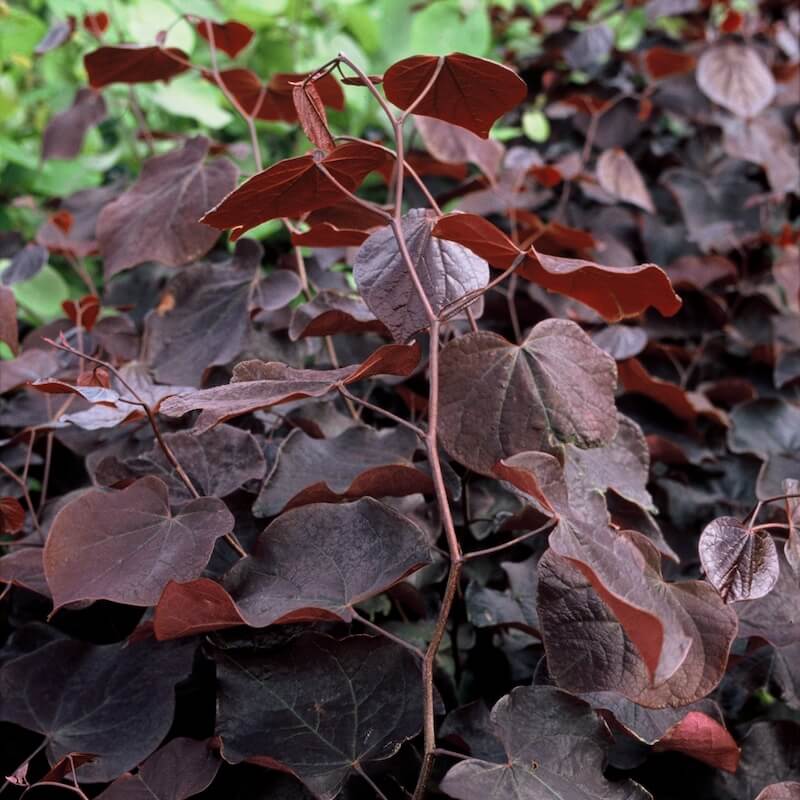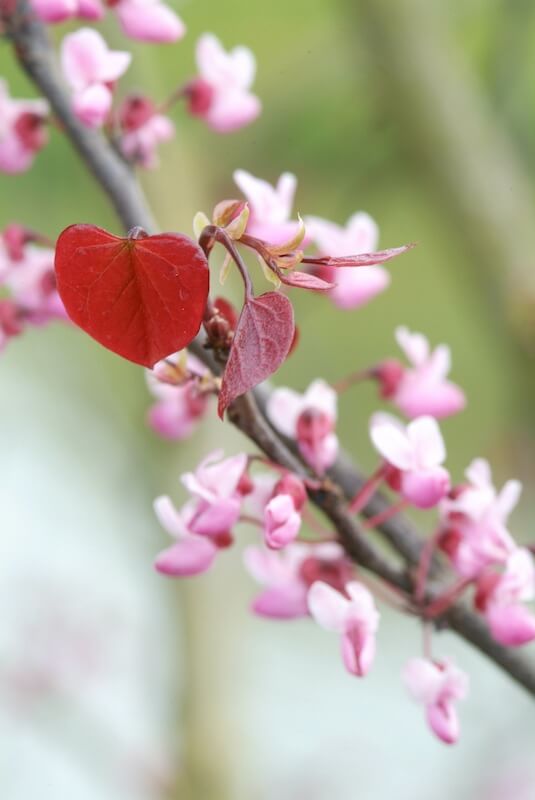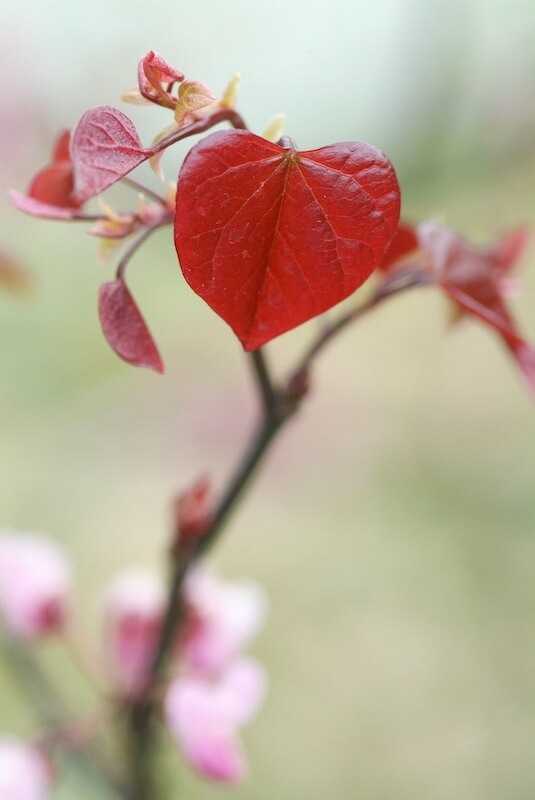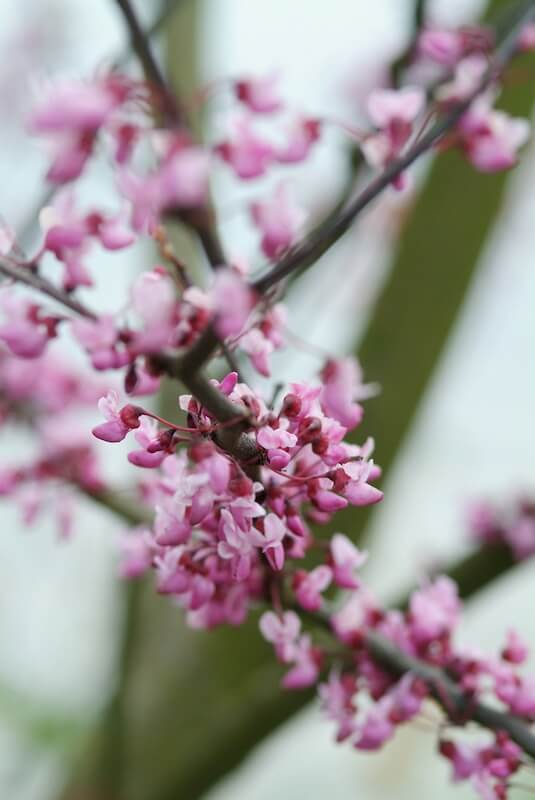Cercis canadensis Forest Pansy – The Eastern Redbud That Transforms Every Season
Eastern Redbud Forest Pansy, Cercis canadensis Purple Leaf

Position
- Prefers full sun to light shade; full sun brings out the deepest leaf colour
- Sheltered from strong winds to protect late spring blossom and tender new shoots
- Ideal as a specimen in lawns or mixed borders, and beneath light tree canopies
Hardiness
- Tolerates winter lows down to about –20 °C (–4 °F)
- Reliable across the UK; a mulch of compost around the root zone helps young specimens in exposed sites
Soil
- Thrives in deep, well-drained, fertile soils
- Benefits from soil improvement with garden compost or well-rotted manure at planting
- Avoids heavy, waterlogged clay and very free-draining, poor sands without improvement
- Adapts to acid, neutral or alkaline conditions
- Performs best where organic matter maintains a stable structure and consistent moisture
- Grab a soil test kit and ensure the perfect conditions for growth
Height
- Typically reaches 4–5 m (13–16 ft) tall with a similar spread, forming a broadly rounded canopy
Seasons of Interest
- Flowering: Upright clusters of pea-like, pale pink to mauve blossoms appear along bare stems in April–May
- Foliage: Emerging leaves flush deep purple in spring, maturing to burgundy-purple through summer for rich, ongoing colour
- Autumn Colour: Leaves turn golden-yellow before falling in October–November, adding late-season interest and contrast
Additional Notes
- Prune immediately after flowering to maintain shape and remove any dead or crossing branches
- Mulch each spring with garden compost to improve moisture retention and support healthy root growth
- Provide regular watering in dry spells for the first two to three years; drought-tolerant thereafter
- Attracts bees with its early flowers and provides habitat for garden wildlife
- Generally pest and disease resistant; monitor for occasional leaf spot in very wet summers
Cercis canadensis Forest Pansy – A Stunning Ornamental Tree for All Seasons
Cercis canadensis Forest Pansy is one of the most striking ornamental trees you can grow, offering year-round visual interest. Known as the eastern redbud, this award-winning Cercis canadensis variety is celebrated for its deep purple foliage, bright pink spring blossom, and outstanding seasonal colour changes. Native to eastern and central North America, it’s as tough as it is beautiful, making it a favourite for gardeners who want bold impact without excessive maintenance.
What Makes Cercis canadensis Such a Garden Treasure?
Cercis canadensis is a large deciduous shrub or small tree native to eastern and central North America from Connecticut to New York, southern Ontario and the Great Lakes south to western Texas and Florida. In the UK, it’s grown for its spectacular spring flowering and ornamental foliage that evolves through the seasons.
This deciduous tree produces bright pink, pea-like flowers in early spring, often before any leaves appear on the bare stems. The flowers appear in clusters, giving an early boost of colour after winter. The foliage follows, with broadly heart-shaped leaves that can be green, red-purple, or deep purple depending on the variety.
The species includes popular ornamental trees like Forest Pansy, which has become a garden classic. It’s a plant that offers interest in every season, thriving in fertile, well-drained soil and providing structural beauty whether planted alone or among other trees and shrubs.
Why is Forest Pansy the Star of Redbud Trees?
Forest Pansy, or Cercis canadensis Forest Pansy, is an award-winning Cercis canadensis that has earned the RHS Award of Garden Merit. It’s valued for its deep purple foliage that holds its colour well into summer, before turning attractive shades of orange, red, and yellow in autumn.
In spring, pink flowers appear on the bare stems, creating a vivid contrast with the dark bark. This spectacle is followed by the emergence of striking foliage that makes Forest Pansy stand out among other redbud trees. The leaves are broadly heart-shaped and develop rich colour tones that change with the seasons.

Where Should You Plant an Eastern Redbud?
An eastern redbud will flourish in full sun to part shade. In hot summer climates, part shade is best to prevent leaf scorch, and shade is best in hot, dry weather. In cooler areas, full sun brings the best flower production and strongest foliage colour.
Choose a sheltered site with well-drained soil enriched with garden compost or well-rotted organic matter. Avoid areas prone to waterlogging, as Cercis canadensis prefers drained soils. It transplants well when young so you can position it with confidence in its permanent spot.
Because it flowers on bare branches, plant it where you can enjoy the spring display up close – perhaps near a patio, garden path, or seating area.
How Does the Flowering Cycle Work?
The flowers appear on the bare stems from early to mid-spring, often before other trees have leafed out. These bright pink or deep pink blooms are pea-like in form and grow in clusters directly from the wood.
This early performance makes Cercis canadensis a valuable addition to ornamental borders and mixed planting schemes. The pink flowers appear in succession, extending the display period. Once the flowers fade, foliage quickly takes over, providing a fresh wave of seasonal interest.

What is Special About the Foliage?
Forest Pansy’s foliage is one of its defining features. The deep purple foliage emerges after flowering, offering a strong contrast to the surrounding greenery.
As the season progresses, the leaves shift to attractive shades of red-purple, then to warm tones of orange, gold, and bronze in autumn. This colourful finale is especially vivid in a sunny position. The broadly heart-shaped leaves add textural softness to the tree’s overall shape, making it a standout focal point.
How Big Will a Forest Pansy Grow?
A mature Forest Pansy will typically reach 4–5 metres in height and spread, though it can be kept smaller with light pruning. It’s often multi-stemmed, which adds to its ornamental appeal and allows it to be shaped for your garden’s needs.
It can be grown as a large shrub or trained as a multi-stemmed tree. As a vigorous grower, it establishes quickly and makes an impact within a few years. The ultimate size makes it ideal for mid-sized gardens, where it won’t overwhelm the space.
What Does the Foliage Look Like?
Once the flowers fade, heart-shaped leaves emerge in a fresh, rich green colour. These glossy leaves remain attractive through summer, giving the shrub a lush appearance.
In autumn, the foliage turns yellow, sometimes with hints of buttery gold. The leaves are shed in autumn, leaving the upright shoots bare once again and ready for another spring display.
How to Care for Cercis canadensis Forest Pansy Year-Round
Cercis canadensis is easily grown if provided with the right conditions. Plant in fertile, well-drained soil and water regularly in its first few seasons to help establish strong roots. Mulching with garden compost in spring will conserve moisture and feed the plant.
Lightly prune after flowering to remove dead or crossing branches, but avoid heavy pruning as it may affect the following year’s flowers. Keep an eye out for pests such as leaf hoppers and diseases like verticillium wilt, canker, blight, and leaf spots. Prompt action at the first signs of trouble will help prevent dieback.
In dry weather, water deeply once a week to maintain healthy foliage colour. In very hot summer climates, part shade is best to protect the leaves from scorch.
Is Forest Pansy Suitable for Smaller Gardens?
Yes, Forest Pansy is perfect for gardens where space is at a premium. Its adaptable growth habit means it can be maintained as a compact, large shrub or small tree.
It’s also an excellent choice for planting in a focal position, such as near a patio, where its spring flowers and summer foliage can be appreciated at close range. With its ornamental form and seasonal changes, it adds interest all year.
Common Problems and How to Avoid Them
Cercis canadensis is generally trouble-free but can suffer from verticillium wilt, especially in poorly drained soils. Choosing a well-drained site is essential. Keep soil fertile and avoid overwatering.
Watch for pests such as leaf hoppers, which can cause minor damage, and for signs of canker or blight. Good garden hygiene, such as removing fallen leaves and pruning out diseased wood, will help prevent problems.
Why Every Gardener Should Consider an Award-Winning Cercis canadensis
Forest Pansy combines striking foliage, beautiful spring flowers, and a manageable size into one plant. It’s a plant that works hard for the space it takes, giving three distinct seasons of interest.
It’s also remarkably adaptable, thriving in sun or partial shade, tolerating a range of soils, and offering value as both a feature tree and a background plant in mixed planting schemes. As an award-winning Cercis canadensis with the RHS seal of approval, it’s a proven choice for UK gardens.
From Darren’s Patch
Forest Pansy never fails to catch my eye — its deep purple foliage and the bright pink spring blossom deliver instant theatre in the garden. I recommend it to gardeners who want bold impact without endless upkeep: plant it where you can see the bare-stem flowers up close, perhaps by a patio or as a focal point in a mixed border. It’s compact yet striking, and a light feed in spring with a spring mulch of compost keeps it looking its best. Take care to give it well-drained soil and a sheltered spot in hot summers, and you’ll be rewarded with reliable colour from March through autumn. For someone seeking seasonal drama that’s simple to grow, Forest Pansy is hard to beat.
![]()
Key Points to Remember
- Seasonal Interest: Pink flowers in spring, deep purple foliage in summer, and shades of orange in autumn
- Size: Large deciduous shrub or small tree, often multi-stemmed, reaching 4–5m
- Site: Full sun to part shade; shade is best in hot summer climates
- Soil: Fertile, well-drained soil enriched with compost
- Care: Easily grown, water in dry weather, prune lightly after flowering
- Pests & Diseases: Watch for verticillium wilt, leaf hoppers, canker, blight, and leaf spots
- Position: Ideal for patios, borders, or as a standalone ornamental tree
Cercis canadensis Forest Pansy excels in sun to light shade on deep, improved soils of any pH, enduring down to –20 °C (–4 °F). Within 5–10 years, it reaches 4–5 m (13–16 ft), offering pink spring blossom, rich purple summer foliage and golden autumn tones. Simple pruning, spring mulching and early watering ensure a vibrant, low-maintenance feature in UK gardens.
Want to learn about other ornamental tree varieties? Read about Cercis chinensis Avondale here.
For more information on Ornamental Trees for your garden, please click here.

Frequently Asked Questions
Q: What is Cercis canadensis Forest Pansy, and why is it so popular?
A: Cercis canadensis Forest Pansy is an award-winning Cercis canadensis variety, admired for its striking foliage and seasonal interest. This deciduous tree or large shrub is often multi-stemmed and produces masses of pea-like flowers in bright pink or deep purple tones that appear on the bare stems in spring. These are followed by broadly heart-shaped leaves in deep purple foliage that mature to attractive shades of orange, red-purple and gold in autumn. A versatile ornamental choice, it has earned the RHS Award of Garden Merit for its beauty and reliability, making it a favourite among gardeners and lovers of ornamental trees.
Q: Where is the Eastern Redbud native to?
A: The eastern redbud, including Cercis canadensis Forest Pansy, is native to eastern and central North America from Connecticut to New York, southern Ontario and the Great Lakes south to western Texas and Florida. It thrives naturally in drained soils in woodland edges and open spaces. Its adaptability and ornamental qualities have made it a highly valued feature in gardens far beyond its native range. Gardeners appreciate its ability to combine spring blossom, vibrant summer foliage and rich autumn colour in one easily grown and versatile plant.
Q: When do the flowers appear on Cercis canadensis?
A: The pink flowers appear on the bare branches from early spring, often before many other ornamental trees and shrubs have stirred from winter dormancy. In Cercis canadensis Forest Pansy, these pea-like flowers appear in dense clusters along bare stems, creating a show-stopping display. Flowers appear on the bare stems in March or April, depending on the climate, and are followed by lush foliage that carries the display through summer and autumn. Their ability to flower before leaf emergence is one of the key reasons they are so highly prized.
Q: How should I plant and care for a Forest Pansy?
A: Plant your Cercis canadensis Forest Pansy in well-drained soil enriched with garden compost or well-rotted compost. Choose a position in full sun to part shade; part shade is best in hot summer climates. Once established, it is remarkably tolerant of dry weather. Feed lightly in spring, water during prolonged dry spells, and prune only to maintain shape after flowering. A mulch in spring helps retain moisture and improve soil fertility. With minimal care, this large deciduous shrub or small tree will reward you with year-round beauty.
Q: What size does a Cercis canadensis Forest Pansy reach?
A: A mature Forest Pansy typically grows into a large shrub or small tree, often multi-stemmed, reaching 4–7 metres in height with a similar spread. This manageable size makes it suitable for patios, medium-sized gardens, and as a focal point in larger landscapes. Its elegant form and seasonal interest ensure it looks impressive in every season, from spring’s bright pink blooms to the deep purple foliage of summer and the shades of orange, gold, and red-purple in autumn.
Q: Does Forest Pansy prefer sun or shade?
A: For the best flowering and foliage colour, plant your Cercis canadensis Forest Pansy in full sun to part shade. In regions with very hot summers, shade is best in the hottest afternoons to prevent leaf scorch. This adaptable ornamental will tolerate a range of light conditions, but brighter sites encourage more intense leaf colour and a richer autumn display. The combination of sun or partial shade, well-drained soil, and protection from harsh winds will help it thrive for decades.
Q: Can Forest Pansy grow in containers?
A: While Cercis canadensis Forest Pansy is more often planted directly in the ground, it can be grown in a large container on a patio if given the proper care. Use a loam-based compost, ensure excellent drainage, and feed in spring. Container-grown plants will need more frequent watering during dry weather and may require root pruning every few years. Growing in pots allows you to position this ornamental tree for maximum impact when its flowers appear and to showcase its striking foliage close-up.
Q: How do I prune a Cercis canadensis Forest Pansy?
A: Forest Pansy requires minimal pruning. Remove any dead, damaged or crossing branches after flowering, avoiding heavy cuts as this can affect the next season’s display. It’s best to prune lightly to preserve the natural multi-stemmed tree shape. Always use clean, sharp tools to prevent the spread of diseases such as canker, verticillium wilt or blight. This low-maintenance approach helps retain its elegant form while ensuring strong growth and abundant flowering year after year.
Q: Are there any pests or diseases to watch for?
A: Cercis canadensis Forest Pansy is generally trouble-free but can be affected by leaf hoppers, canker, verticillium wilt, dieback, blight and leaf spots in some conditions. Good air circulation, well-drained soil and avoiding waterlogging will reduce the risk. Promptly remove and dispose of any diseased material, and keep the plant healthy with regular feeding, mulching, and watering in dry weather. Its resilience and adaptability make it one of the more reliable ornamental trees for UK gardens.
Q: Where can I buy a Cercis canadensis Forest Pansy?
A: Cercis canadensis Forest Pansy is widely available from garden centres, specialist nurseries and reputable online plant retailers. When buying, look for healthy, well-branched specimens with no signs of pests or diseases. Choosing a quality plant from a trusted source ensures your award-winning Cercis canadensis will establish quickly and thrive, rewarding you with masses of pea-like flowers in spring, deep purple foliage in summer and spectacular autumn colour.
